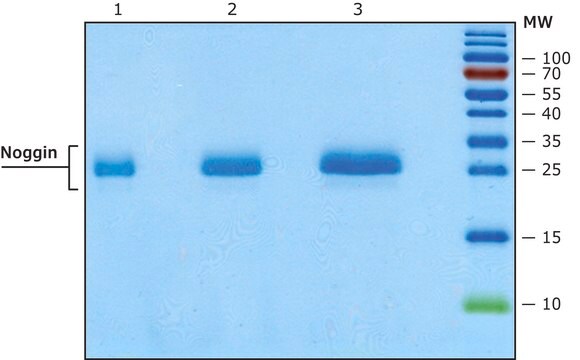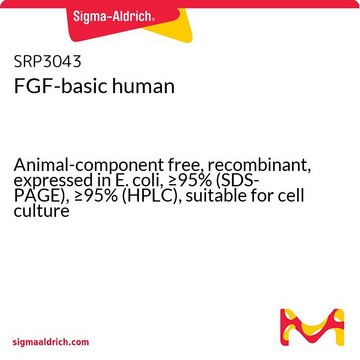SRP3040
FGF-9 human
recombinant, expressed in E. coli, ≥95% (SDS-PAGE), ≥95% (HPLC), suitable for cell culture
Synonym(e):
Fibroblast Growth Factor-9, GAF (Glia-activating factor), HBGF-9
Anmeldenzur Ansicht organisationsspezifischer und vertraglich vereinbarter Preise
Alle Fotos(1)
About This Item
UNSPSC-Code:
12352202
NACRES:
NA.32
Empfohlene Produkte
Biologische Quelle
human
Rekombinant
expressed in E. coli
Assay
≥95% (HPLC)
≥95% (SDS-PAGE)
Form
lyophilized
Wirksamkeit
≥2x10^6 units/mg
Mol-Gew.
23.4 kDa
Verpackung
pkg of 20 μg
Methode(n)
cell culture | mammalian: suitable
Verunreinigungen
<0.1 EU/μg endotoxin, tested
Farbe
white to off-white
UniProt-Hinterlegungsnummer
Versandbedingung
wet ice
Lagertemp.
−20°C
Angaben zum Gen
human ... FGF9(2254)
Allgemeine Beschreibung
FGF9 (fibroblast growth factor 9) is a member of the FGF family, which consists of a minimum of 24 members. This protein is highly conserved across species, and the gene is localized to human chromosome 13q11-q12. In embryos, FGF9 mRNA has a ubiquitous expression pattern. In adults, this protein has a limited range of expression in normal conditions, and expression is usually restricted to brain, kidney and uterus.
Recombinant human FGF-9 is a 23.4kDa protein consisting of 207 amino acid residues.
Recombinant human FGF-9 is a 23.4kDa protein consisting of 207 amino acid residues.
Biochem./physiol. Wirkung
FGF9 (fibroblast growth factor 9) is expressed in the epithelium and mesothelium of developing lung in the pseudoglandular stage. In developing lungs, it regulates the branching of epithelium, proliferation of mesenchymal cells, and expansion of the lungs. It is overexpressed in patients with idiopathic pulmonary fibrosis (IPF), in regions demonstrating active cell hyperplasia, metaplasia and fibrosis. Thus, it might facilitate the pathogenesis of IPF. The expression of this protein is up-regulated in colon cancer, which is an outcome of hypoxia-induced translational activation.
Sequenz
MAPLGEVGNY FGVQDAVPFG NVPVLPVDSP VLLSDHLGQS EAGGLPRGPA VTDLDHLKGI LRRRQLYCRT GFHLEIFPNG TIQGTRKDHS RFGILEFISI AVGLVSIRGV DSGLYLGMNE KGELYGSEKL TQECVFREQF EENWYNTYSS NLYKHVDTGR RYYVALNKDG TPREGTRTKR HQKFTHFLPR PVDPDKVPEL YKDILSQS
Physikalische Form
Lyophilized from 10 mM Sodium Phosphate, pH 7.8 + 50 mM NaCl.
Rekonstituierung
Centrifuge the vial prior to opening. Reconstitute in water to a concentration of 0.1- 1.0 mg/ml. Do not vortex. This solution can be stored at 2-8°C for up to 1 week. For extended storage, it is recommended to further dilute in a buffer containing a carrier protein (example 0.1% BSA) and store in working aliquots at -20°C to -80°C.
Lagerklassenschlüssel
11 - Combustible Solids
WGK
WGK 3
Flammpunkt (°F)
Not applicable
Flammpunkt (°C)
Not applicable
Hier finden Sie alle aktuellen Versionen:
Besitzen Sie dieses Produkt bereits?
In der Dokumentenbibliothek finden Sie die Dokumentation zu den Produkten, die Sie kürzlich erworben haben.
Emily Coffey et al.
The journal of histochemistry and cytochemistry : official journal of the Histochemistry Society, 61(9), 671-679 (2013-06-26)
The fibroblast growth factor (FGF) family of signaling ligands contributes significantly to lung development and maintenance in the adult. FGF9 is involved in control of epithelial branching and mesenchymal proliferation and expansion in developing lungs. However, its activity and expression
Tsung-Ming Chen et al.
Nucleic acids research, 42(5), 2932-2944 (2013-12-18)
Human fibroblast growth factor 9 (FGF9) is a potent mitogen involved in many physiological processes. Although FGF9 messenger RNA (mRNA) is ubiquitously expressed in embryos, FGF9 protein expression is generally low and restricted to a few adult organs. Aberrant expression
Sung Mi Cho et al.
The Journal of biological chemistry, 290(47), 28502-28514 (2015-09-26)
Cyanobacteriochromes (CBCRs), which are exclusive to and widespread among cyanobacteria, are photoproteins that sense the entire range of near-UV and visible light. CBCRs are related to the red/far-red phytochromes that utilize linear tetrapyrrole (bilin) chromophores. Best characterized from the unicellular
Chao Sun et al.
BMC cancer, 15, 333-333 (2015-05-01)
Cancer-associated fibroblasts (CAFs), which reside around tumor cells, are suggested to play a pivotal role in tumor progression. Here we performed microarray analyses to compare gene expression profiles between CAFs and non-cancerous gastric fibroblasts (NGFs) from a patient with gastric
Fibroblast growth factors.
Ornitz, D.M., et al.
Genome Biology, 2, 30051-300512 (2001)
Unser Team von Wissenschaftlern verfügt über Erfahrung in allen Forschungsbereichen einschließlich Life Science, Materialwissenschaften, chemischer Synthese, Chromatographie, Analytik und vielen mehr..
Setzen Sie sich mit dem technischen Dienst in Verbindung.








